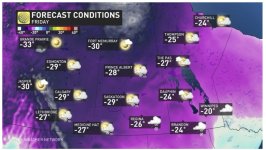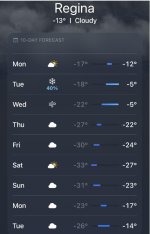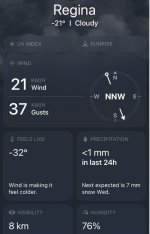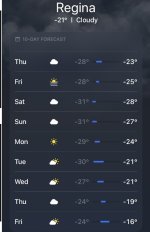It's Climate Change I tell'ya!! IT'S CLIMATE CHANGE!!
- Thread starter B00Mer
- Start date
You are using an out of date browser. It may not display this or other websites correctly.
You should upgrade or use an alternative browser.
You should upgrade or use an alternative browser.
So. . . she did honest work once?AOC is early 30s. She used to be a waitress.
You trust waitresses? Simp!So. . . she did honest work once?
Avian flu feared in Canadian polar bears after disease kills bear in Alaska
Author of the article:Canadian Press
Canadian Press
Bob Weber
Published Jan 04, 2024 • Last updated 1 day ago • 3 minute read
Scientists fear Canadian polar bears may be threatened by the spread of avian flu after officials confirmed the disease killed a bear in Alaska.
Scientists fear Canadian polar bears may be threatened by the spread of avian flu after officials confirmed the disease killed a bear in Alaska.
“There’s a very high likelihood that it is (in Canadian bears),” said Andrew Derocher, a leading polar bear biologist at the University of Alberta.
“It’s there. We just aren’t looking for it.”
Last month, officials with the U.S. Department of Agriculture confirmed the H5N1 strain of avian flu killed a polar bear, found in October near the Alaskan town of Utqiagvik about 500 kilometres from the Yukon border. Polar bears range hundreds of kilometres and the dead bear was part of a population shared by both countries.
The virus first showed up in Yukon more than a year ago in a red fox, said territorial veterinarian Jane Harms.
“This strain of avian flu seems to have the ability to infect and cause disease in mammals of a variety of types,” she said. “The fact this virus can cause disease and death in polar bears, as well as other species, is of concern.”
It’s not clear yet how far the virus has spread among Arctic mammals. Alaska has found it in red foxes, a black bear and a Kodiak bear.
Harms said it seems so far it is being spread when mammals eat infected birds.
“In most cases, wild mammals are being infected by scavenging tissues of infected birds. It does not seem to be transmitted mammal to mammal.”
But Derocher said climate change is likely increasing the bears’ exposure, as diminishing sea ice keeps them on shore longer and forces them to subsist on prey such as dead birds. Those extended shorebound periods of relative scarcity also weaken the bears.
“Immune system function goes down. With weakened immune systems, they’re more likely to succumb.”
As well, polar bears are more vulnerable to viruses than other bears, said John Whiteman, chief researcher at Polar Bears International and professor at Old Dominion University in Virginia. While evolving for the Arctic, they lost much of their genetic “library” of possible pathogens and how to resist them.
“If you can recognize a lot of pathogens, you’re in better shape to fight them off,” said Whiteman. “Polar bears don’t recognize a lot of pathogens.”
Climate change has stirred the pot on viruses around the world, he said.
“We know that pathogens are changing their distribution and some of them that may not have been able to survive the north slope of Alaska are gaining a foothold.”
Avian flu is now found on every continent except Australia.
Both Whiteman and Derocher called for better monitoring of wildlife diseases.
Harms said Yukon regularly performs necropsies on dead wildlife, but more needs to be done. Confirming avian flu requires extra testing, she said.
“The reality is we probably would have more avian flu virus infection in mammals if we had the ability to look for it.”
The Southern Beaufort population of which the dead bear was a member is estimated to be about 900 strong, although it’s hard to be sure with polar bears. That population is considered to have declined by about 50 per cent since the 1980s, said Derocher.
The virus has hit other mammals hard. Scientists have linked it to the deaths of nearly 500 seals in Maine over the last two years.
But both Derocher and Whiteman say one bear death isn’t enough to push the virus panic button.
“I would put it in the category of a little alarming,” said Whiteman. “This threat still has so much unknown to it. But there is a potential for mortality.
“By far, the biggest threat to this species is the loss of sea ice.”

 torontosun.com
torontosun.com
Author of the article:Canadian Press
Canadian Press
Bob Weber
Published Jan 04, 2024 • Last updated 1 day ago • 3 minute read
Scientists fear Canadian polar bears may be threatened by the spread of avian flu after officials confirmed the disease killed a bear in Alaska.
Scientists fear Canadian polar bears may be threatened by the spread of avian flu after officials confirmed the disease killed a bear in Alaska.
“There’s a very high likelihood that it is (in Canadian bears),” said Andrew Derocher, a leading polar bear biologist at the University of Alberta.
“It’s there. We just aren’t looking for it.”
Last month, officials with the U.S. Department of Agriculture confirmed the H5N1 strain of avian flu killed a polar bear, found in October near the Alaskan town of Utqiagvik about 500 kilometres from the Yukon border. Polar bears range hundreds of kilometres and the dead bear was part of a population shared by both countries.
The virus first showed up in Yukon more than a year ago in a red fox, said territorial veterinarian Jane Harms.
“This strain of avian flu seems to have the ability to infect and cause disease in mammals of a variety of types,” she said. “The fact this virus can cause disease and death in polar bears, as well as other species, is of concern.”
It’s not clear yet how far the virus has spread among Arctic mammals. Alaska has found it in red foxes, a black bear and a Kodiak bear.
Harms said it seems so far it is being spread when mammals eat infected birds.
“In most cases, wild mammals are being infected by scavenging tissues of infected birds. It does not seem to be transmitted mammal to mammal.”
But Derocher said climate change is likely increasing the bears’ exposure, as diminishing sea ice keeps them on shore longer and forces them to subsist on prey such as dead birds. Those extended shorebound periods of relative scarcity also weaken the bears.
“Immune system function goes down. With weakened immune systems, they’re more likely to succumb.”
As well, polar bears are more vulnerable to viruses than other bears, said John Whiteman, chief researcher at Polar Bears International and professor at Old Dominion University in Virginia. While evolving for the Arctic, they lost much of their genetic “library” of possible pathogens and how to resist them.
“If you can recognize a lot of pathogens, you’re in better shape to fight them off,” said Whiteman. “Polar bears don’t recognize a lot of pathogens.”
Climate change has stirred the pot on viruses around the world, he said.
“We know that pathogens are changing their distribution and some of them that may not have been able to survive the north slope of Alaska are gaining a foothold.”
Avian flu is now found on every continent except Australia.
Both Whiteman and Derocher called for better monitoring of wildlife diseases.
Harms said Yukon regularly performs necropsies on dead wildlife, but more needs to be done. Confirming avian flu requires extra testing, she said.
“The reality is we probably would have more avian flu virus infection in mammals if we had the ability to look for it.”
The Southern Beaufort population of which the dead bear was a member is estimated to be about 900 strong, although it’s hard to be sure with polar bears. That population is considered to have declined by about 50 per cent since the 1980s, said Derocher.
The virus has hit other mammals hard. Scientists have linked it to the deaths of nearly 500 seals in Maine over the last two years.
But both Derocher and Whiteman say one bear death isn’t enough to push the virus panic button.
“I would put it in the category of a little alarming,” said Whiteman. “This threat still has so much unknown to it. But there is a potential for mortality.
“By far, the biggest threat to this species is the loss of sea ice.”

Avian flu feared in Canadian polar bears after disease kills bear in Alaska
Scientists fear Canadian polar bears may be threatened by the spread of avian flu after the disease killed a bear in Alaska.
Alaska?
wouldn't that be a 'murkin bear?
or do they just let anyone cross the border unchecked up there as well?
(and no, I didn't read the damn article. I'm just shooting from the hip. maybe I'll read it now lol)
wouldn't that be a 'murkin bear?
or do they just let anyone cross the border unchecked up there as well?
(and no, I didn't read the damn article. I'm just shooting from the hip. maybe I'll read it now lol)
“The reality is we probably would have more avian flu virus infection in mammals if we had the ability to look for it.”
hmmm SCIENCE!
so the more they test... lol
maybe just stop testing and there probably could be less birdie flu?
I luv sounding all scientifical and edjumacated like that.
:?D
It’s gonna Climate Change this week!!

 apple.news
Later this week, daytime highs on the Prairies will struggle to go above -30°C –– an extremely rare feat during an El Niño winter.
apple.news
Later this week, daytime highs on the Prairies will struggle to go above -30°C –– an extremely rare feat during an El Niño winter.
After the mild December where the coldest air in the Northern Hemisphere stalled over Siberia, the tables have turned. Now, the coldest temperatures relative to normal on the entire globe will be across British Columbia and the western Prairies. Good times.
Severe cold snap defies El Niño, brings extreme chill, snow to the Prairies — The Weather Network
A drastic change is coming in Western Canada, with significantly colder air moving in from the Arctic this week. Temperatures will plummet into the -20s, and even -30s for some areas, so make sure to stay warm and limit any outdoor exposure
After the mild December where the coldest air in the Northern Hemisphere stalled over Siberia, the tables have turned. Now, the coldest temperatures relative to normal on the entire globe will be across British Columbia and the western Prairies. Good times.
Im ready. When global warming returns it will feel extra hot. Cuz -29 is hotter than -30.It’s gonna Climate Change this week!!
Later this week, daytime highs on the Prairies will struggle to go above -30°C –– an extremely rare feat during an El Niño winter.
Severe cold snap defies El Niño, brings extreme chill, snow to the Prairies — The Weather Network
A drastic change is coming in Western Canada, with significantly colder air moving in from the Arctic this week. Temperatures will plummet into the -20s, and even -30s for some areas, so make sure to stay warm and limit any outdoor exposureapple.news
After the mild December where the coldest air in the Northern Hemisphere stalled over Siberia, the tables have turned. Now, the coldest temperatures relative to normal on the entire globe will be across British Columbia and the western Prairies. Good times.
Yes. You win the nobull prize.So does that mean globull warming is over?
When did it start ?So does that mean globull warming is over?
Extreme cold and bitter winds are pushing in from the Arctic through Yukon, the Northwest Territories, B.C., Alberta and Saskatchewan, bringing wind chill temperatures to as low as -55 C in some regions. Good times.

 apple.news
Environment (& Climate Change) Canada says extreme cold puts everyone at risk, but the risks are greater for children, older adults, people with chronic illnesses, those working or exercising outdoors, and people who don't have proper shelter.
apple.news
Environment (& Climate Change) Canada says extreme cold puts everyone at risk, but the risks are greater for children, older adults, people with chronic illnesses, those working or exercising outdoors, and people who don't have proper shelter.
“Watch for cold-related symptoms: shortness of breath, chest pain, muscle pain and weakness, numbness and colour change in fingers and toes," Environment (& Climate Change) Canada says in its forecast.
The warnings of "the first arctic intrusion of the year" from Environment Canada cover parts of the territories, much of central and northern British Columbia and northern sections of Alberta and Saskatchewan.
A forecaster with Avalanche (& Climate Change?) Canada says outdoor enthusiasts shouldn't let their excitement over recent heavy snowfalls override the need for caution.
James Floyer says while some might feel the dump of snow means the "gates to Nirvana have opened" on Western Canada's mountains, the snow will take until at least Friday to settle and will be particularly susceptible to avalanches in the meantime.

Blast of arctic air over Western Canada could bring wind chill that feels like -55 — The Canadian Press
REVELSTOKE, B.C. - Extreme cold and bitter winds are pushing in from the Arctic through Yukon, the Northwest Territories, B.C., Alberta and Saskatchewan, bringing wind chill that feels as low as -55 in some regions.
“Watch for cold-related symptoms: shortness of breath, chest pain, muscle pain and weakness, numbness and colour change in fingers and toes," Environment (& Climate Change) Canada says in its forecast.
The warnings of "the first arctic intrusion of the year" from Environment Canada cover parts of the territories, much of central and northern British Columbia and northern sections of Alberta and Saskatchewan.
A forecaster with Avalanche (& Climate Change?) Canada says outdoor enthusiasts shouldn't let their excitement over recent heavy snowfalls override the need for caution.
James Floyer says while some might feel the dump of snow means the "gates to Nirvana have opened" on Western Canada's mountains, the snow will take until at least Friday to settle and will be particularly susceptible to avalanches in the meantime.

Earth shattered global heat record in 2023 and it’s flirting with warming limit, European agency says
Author of the article:Associated Press
Associated Press
Seth Borenstein
Published Jan 09, 2024 • Last updated 1 day ago • 4 minute read
Earth last year shattered global annual heat records, flirted with the world’s agreed-upon warming threshold and showed more signs of a feverish planet, the European climate agency said Tuesday.
In one of the first of several teams of science agencies to calculate how off-the-charts warm 2023 was, the European climate agency Copernicus said the year was 1.48 degrees Celsius (2.66 degrees Fahrenheit) above pre-industrial times. That’s barely below the 1.5 degrees Celsius limit that the world hoped to stay within in the 2015 Paris climate accord to avoid the most severe effects of warming.
And January 2024 is on track to be so warm that for the first time a 12-month period will exceed the 1.5-degree threshold, Copernicus Deputy Director Samantha Burgess said. Scientists have repeatedly said that Earth would need to average 1.5 degrees of warming over two or three decades to be a technical breach of the threshold.
The 1.5 degree goal “has to be (kept) alive because lives are at risk and choices have to be made,” Burgess said. “And these choices don’t impact you and I but they impact our children and our grandchildren.”
The record heat made life miserable and sometimes deadly in Europe, North America, China and many other places last year. But scientists say a warming climate is also to blame for more extreme weather events, like the lengthy drought that devastated the Horn of Africa, the torrential downpours that wiped out dams and killed thousands in Libya and the Canada wildfires that fouled the air from North America to Europe. For the first time, nations meeting for annual United Nations climate talks in December agreed that the world needs to transition away from the fossil fuels that are causing climate change, but they set no concrete requirements to do so.
Copernicus calculated that the global average temperature for 2023 was about one-sixth of a degree Celsius (0.3 degrees Fahrenheit) warmer than the old record set in 2016. While that seems a small amount in global record-keeping, it’s an exceptionally large margin for the new record, Burgess said. Earth’s average temperature for 2023 was 14.98 degrees Celsius (58.96 degrees Fahrenheit), Copernicus calculated.
“It was record-breaking for seven months. We had the warmest June, July, August, September, October, November, December,” Burgess said. “It wasn’t just a season or a month that was exceptional. It was exceptional for over half the year.”
There are several factors that made 2023 the warmest year on record, but by far the biggest factor was the ever-increasing amount of greenhouse gases in the atmosphere that trap heat, Burgess said. Those gases come from the burning of coal, oil and natural gas.
Other factors including the natural El Nino — a temporary warming of the central Pacific that alters weather worldwide — other natural oscillations in the Arctic, southern and Indian oceans, increased solar activity and the 2022 eruption of an undersea volcano that sent water vapor into the atmosphere, Burgess said.
Malte Meinshausen, a University of Melbourne climate scientist, said about 1.3 degrees Celsius of the warming comes from greenhouse gases, with another 0.1 degrees Celsius from El Nino and the rest being smaller causes.
Given El Nino and record ocean heat levels, Burgess said it’s “extremely likely” that 2024 will be even hotter than 2023.
Copernicus records only go back to 1940 and are based on a combination of observations and forecast models. Other groups, including the United States’ National Oceanic and Atmospheric Administration and NASA, the United Kingdom’s Meteorological Office and Berkeley Earth go back to the mid-1800s and will announce their calculations for 2023 on Friday, with expectations of record-breaking marks.
The Japanese Meteorological Agency, which uses similar techniques as Copernicus and goes back to 1948, late last month estimated that it was the warmest year at 1.47 degrees Celsius (2.64 degrees Fahrenheit) above pre-industrial levels. The University of Alabama Huntsville global dataset, which uses satellite measurements rather than ground data and dates to 1979, last week also found it the hottest year on record, but not by as much.
Though actual observations only date back less than two centuries, several scientists say evidence from tree rings and ice cores suggest this is the warmest the Earth has been in more than 100,000 years.
“2023 was probably hottest year on Earth in about 125,000 years,” said Woodwell Climate Research Center climate scientist Jennifer Francis. “Humans were around before that but it’s certainly fair to say it’s the hottest since humans became civilized, depending on the definition of ‘civilized.’ ”
Amid record hot months were days that were downright unprecedented hot across the globe.
For the first time, Copernicus recorded a day where the world averaged at least 2 degrees Celsius (3.6 degrees Fahrenheit) more than pre-industrial times. It happened twice and narrowly missed a third day around Christmas, Burgess said.
And for the first time, every day of the year was at least one degree Celsius (1.8 degrees Fahrenheit) warmer than pre-industrial times. For nearly half the year — 173 days — the world was 1.5 degrees warmer than the mid-1800s.
Meinshausen, the Australian climate scientist, said it’s natural for the public to wonder whether the 1.5-degree target is lost. He said it’s important for people to keep trying to rein in warming.
“We are not abolishing a speed limit, because somebody exceeded the speed limit,” he said. “We double our efforts to step on the brakes.”

 torontosun.com
torontosun.com
Author of the article:Associated Press
Associated Press
Seth Borenstein
Published Jan 09, 2024 • Last updated 1 day ago • 4 minute read
Earth last year shattered global annual heat records, flirted with the world’s agreed-upon warming threshold and showed more signs of a feverish planet, the European climate agency said Tuesday.
In one of the first of several teams of science agencies to calculate how off-the-charts warm 2023 was, the European climate agency Copernicus said the year was 1.48 degrees Celsius (2.66 degrees Fahrenheit) above pre-industrial times. That’s barely below the 1.5 degrees Celsius limit that the world hoped to stay within in the 2015 Paris climate accord to avoid the most severe effects of warming.
And January 2024 is on track to be so warm that for the first time a 12-month period will exceed the 1.5-degree threshold, Copernicus Deputy Director Samantha Burgess said. Scientists have repeatedly said that Earth would need to average 1.5 degrees of warming over two or three decades to be a technical breach of the threshold.
The 1.5 degree goal “has to be (kept) alive because lives are at risk and choices have to be made,” Burgess said. “And these choices don’t impact you and I but they impact our children and our grandchildren.”
The record heat made life miserable and sometimes deadly in Europe, North America, China and many other places last year. But scientists say a warming climate is also to blame for more extreme weather events, like the lengthy drought that devastated the Horn of Africa, the torrential downpours that wiped out dams and killed thousands in Libya and the Canada wildfires that fouled the air from North America to Europe. For the first time, nations meeting for annual United Nations climate talks in December agreed that the world needs to transition away from the fossil fuels that are causing climate change, but they set no concrete requirements to do so.
Copernicus calculated that the global average temperature for 2023 was about one-sixth of a degree Celsius (0.3 degrees Fahrenheit) warmer than the old record set in 2016. While that seems a small amount in global record-keeping, it’s an exceptionally large margin for the new record, Burgess said. Earth’s average temperature for 2023 was 14.98 degrees Celsius (58.96 degrees Fahrenheit), Copernicus calculated.
“It was record-breaking for seven months. We had the warmest June, July, August, September, October, November, December,” Burgess said. “It wasn’t just a season or a month that was exceptional. It was exceptional for over half the year.”
There are several factors that made 2023 the warmest year on record, but by far the biggest factor was the ever-increasing amount of greenhouse gases in the atmosphere that trap heat, Burgess said. Those gases come from the burning of coal, oil and natural gas.
Other factors including the natural El Nino — a temporary warming of the central Pacific that alters weather worldwide — other natural oscillations in the Arctic, southern and Indian oceans, increased solar activity and the 2022 eruption of an undersea volcano that sent water vapor into the atmosphere, Burgess said.
Malte Meinshausen, a University of Melbourne climate scientist, said about 1.3 degrees Celsius of the warming comes from greenhouse gases, with another 0.1 degrees Celsius from El Nino and the rest being smaller causes.
Given El Nino and record ocean heat levels, Burgess said it’s “extremely likely” that 2024 will be even hotter than 2023.
Copernicus records only go back to 1940 and are based on a combination of observations and forecast models. Other groups, including the United States’ National Oceanic and Atmospheric Administration and NASA, the United Kingdom’s Meteorological Office and Berkeley Earth go back to the mid-1800s and will announce their calculations for 2023 on Friday, with expectations of record-breaking marks.
The Japanese Meteorological Agency, which uses similar techniques as Copernicus and goes back to 1948, late last month estimated that it was the warmest year at 1.47 degrees Celsius (2.64 degrees Fahrenheit) above pre-industrial levels. The University of Alabama Huntsville global dataset, which uses satellite measurements rather than ground data and dates to 1979, last week also found it the hottest year on record, but not by as much.
Though actual observations only date back less than two centuries, several scientists say evidence from tree rings and ice cores suggest this is the warmest the Earth has been in more than 100,000 years.
“2023 was probably hottest year on Earth in about 125,000 years,” said Woodwell Climate Research Center climate scientist Jennifer Francis. “Humans were around before that but it’s certainly fair to say it’s the hottest since humans became civilized, depending on the definition of ‘civilized.’ ”
Amid record hot months were days that were downright unprecedented hot across the globe.
For the first time, Copernicus recorded a day where the world averaged at least 2 degrees Celsius (3.6 degrees Fahrenheit) more than pre-industrial times. It happened twice and narrowly missed a third day around Christmas, Burgess said.
And for the first time, every day of the year was at least one degree Celsius (1.8 degrees Fahrenheit) warmer than pre-industrial times. For nearly half the year — 173 days — the world was 1.5 degrees warmer than the mid-1800s.
Meinshausen, the Australian climate scientist, said it’s natural for the public to wonder whether the 1.5-degree target is lost. He said it’s important for people to keep trying to rein in warming.
“We are not abolishing a speed limit, because somebody exceeded the speed limit,” he said. “We double our efforts to step on the brakes.”

Earth shattered global heat record in 2023 and it’s flirting with warming limit, European agency says
Earth last year shattered global annual heat records, and flirted with the world's agreed-upon warming threshold, the European climate agency said.
Thank God it cooled off. Yesterday was a scorcher.This….this is why I question Trudeau/Oprah on the “Free?” Heat Pumps thing…
View attachment 20727
I spent a chunk of time in the morning, & another chunk in the afternoon, in my “spare time” trying to get an M2 started. I’m still trying to warm up. Getting old sucks.Thank God it cooled off. Yesterday was a scorcher.





